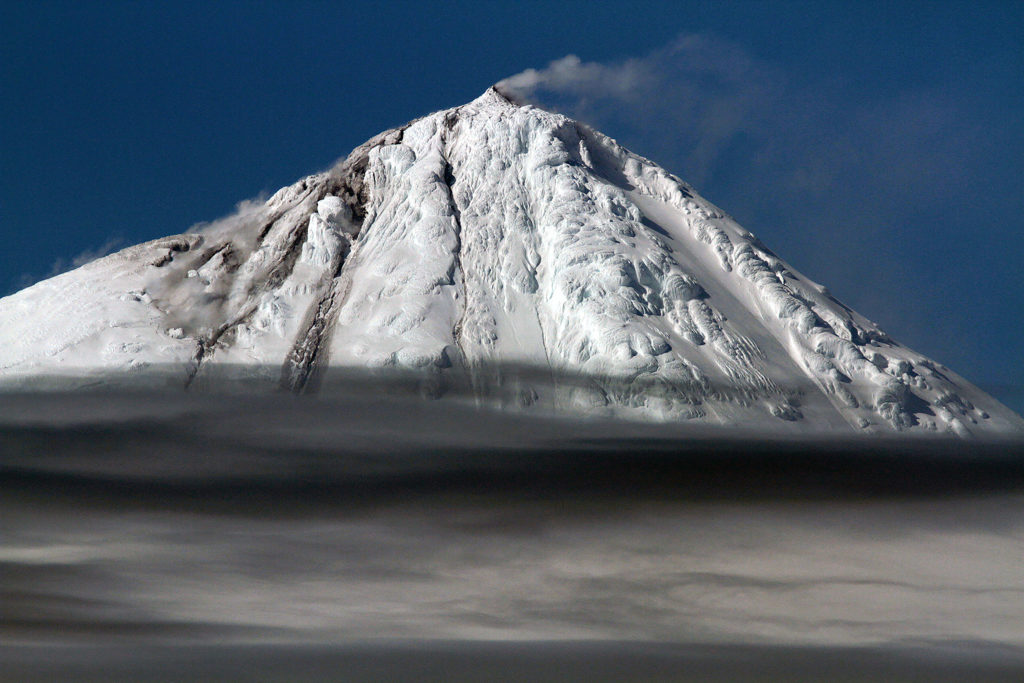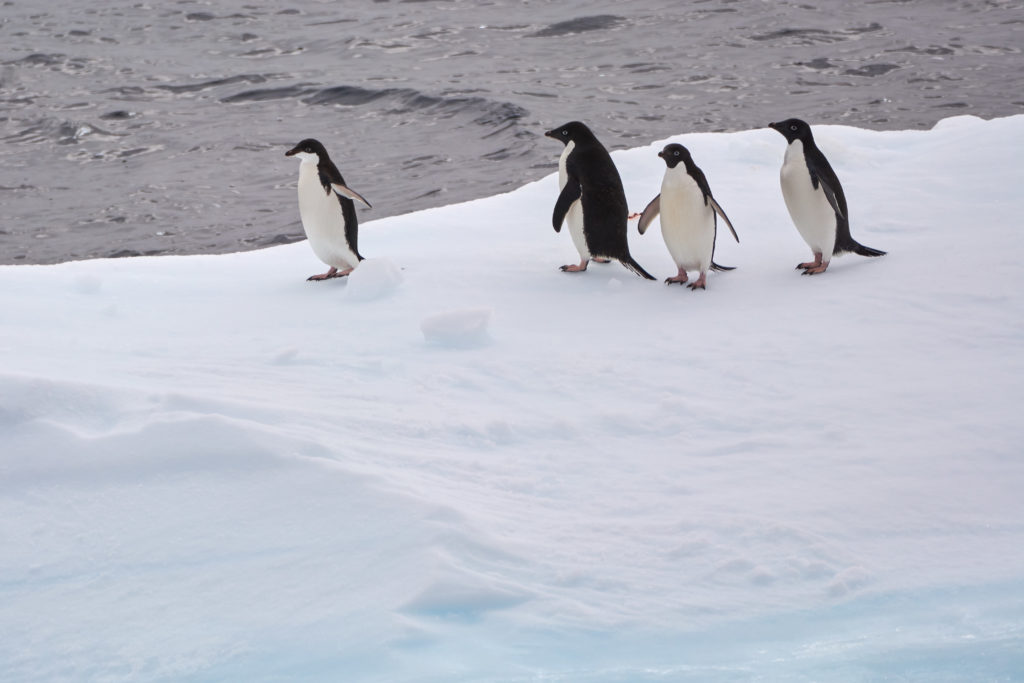
Big Ben erupting, pictured from RV Investigator. Image: Pete Harmsen
96 million years ago Australia and Antarctica were joined at the hip. These days, Antarctica is changing quickly – faster than can be measured by researchers – and it’s in our national and global interest to better understand the state of the Antarctic ice sheet.
Here are some of the ways we’ve helped to better understand Antarctica’s past, as well as its future impact on the surrounding oceans and our climate.
1. We witnessed an Antarctic volcano eruption
We’ll kick it off with a bang: Heard Island, part of Australia’s Antarctic territory since 1947, is one of the most remote places on Earth. Despite the island’s otherwise barren landscape it contains an active volcano, Big Ben, that is so big that it towers over any mountain on Australia’s mainland. (Psst. The island also contains hardy plants and some pretty cute penguins but we’ll get to that later).
While little is known about volcanic activity on Heard Island – and few have been witness to its volcanic eruptions to date – we were around to capture Mawson Peak, the highest point on Big Ben, blowing its lid back in 2016 on an RV Investigator voyage.
As hot, buoyant material flowed from a depth of roughly 2900km all the way up to Earth’s surface, this particular eruption made for essential viewing for a combination of reasons.
Big Ben is an unlikely kind of volcano – it’s called “hotspot” as it’s situated in the middle of a tectonic plate, unlike most volcanos on Earth, which are commonly situated along tectonic plate boundaries.
And it gets more interesting: The Southern Ocean, where Big Ben is located, is anaemic with little dissolved iron present in the water, meaning phytoplankton, microscopic organisms – and superhero plants of the ocean – can’t ordinarily grow. Phytoplankton produce half of the oxygen in the Earth’s atmosphere and, coupled with eruptions (which release gases like carbon dioxide and trace metals like iron into oceans and atmosphere) play a critically important role in life on Earth.
The 2016 voyage identified flares (plumes of gas) coming up from the seafloor several hundred kilometers from Heard and McDonald Islands on the Kerguelen Plateau, which may indicate the presence of volcano-driven hydrothermal springs emitting iron into the water column, and possibly also nourishing phytoplankton.
Another voyage is planned in 2020 on Investigator for 59 days to explore the Kerguelen Plateau, so stayed tuned!

King penguins at Heard Island. Image: Matt Curnock
2. We helped take the Australian ice breaker Aurora Australis to the Totten Glacier, the first ship to ever reach the ice
Thanks to a lucky crack in the sea ice, a team aboard Aurora Australis including some of our researchers along with the Antarctic Climate & Ecosystems CRC, the University of Tasmania, and the Australian Antarctic Division were able to reach an area of the Totten Glacier that was normally impenetrable to ships.
Once there, we were able to take the first measurements of the water column and sea floor of this area. We discovered a river of warm ocean water pouring into the cavity (the underside of the glacier) and melting ice from below.
This was totally new information at the time, and it alerted us to the fact that the East Antarctic ice sheet was more vulnerable than we had previously thought to ocean heat, and sea levels were likely to rise faster and further than what we had estimated.
At the time, Project Leader Steve Rintoul from our oceans and atmosphere team said, ‘If warm ocean waters drive more rapid melt of the Totten and other ice shelves around the edge of Antarctica, more glacial ice can flow into the ocean, raising sea level.’

Totten Glacier calving front, 2014. Image: Paul Brown
3. We’ve gotten up close and personal with some pretty cute wildlife along the way
Okay, we’ll admit it’s not technically research, but we’ve taken some great snaps that have provided joy and motivation to enable a lot of great research to unfold. And we even have one cute patoot penguin hitch a ride with some of researchers.

Adelie penguins seen hitching a ride on an iceberg in Antarctica. Image: Diego Cotterle
4. Our research collections are a veritable repository for Antarctic specimens
Speaking of enabling great research, we’ve got a bustling collection of Antarctic specimens in our national research collections including plants and cryptogams (including the hair grass Deschampsia from Heard Island where Big Ben erupted) at the Australian National Herbarium – a joint venture with Parks Australia. You’ll also find algae at our Australian National Algae Culture Collection, seabirds (including penguins) at our Australian National Wildlife Collection and Antarctic fish in our Australian National Fish Collection.
As custodians of this vast information, we make these resources available for scientists to study in terms of taxonomy and systematics as well as conservation or climate change projects – and also understanding why moss can’t have sex on the sterile surface of Antarctica.

It didn’t quite make the “cute wildlife” category: Bathyraja maccaini, a large deepwater skate from the Antarctic Peninsula, at depths from up to 500m.
5. And we’ve just produced a “choose your own adventure” report on Antarctica in the year 2070
In June, our O&A researchers published a paper in Nature on ‘Choosing the future of Antarctica’. They proposed two scenarios.
In the first, the climate continues to warm as global greenhouse gas emissions go unchecked, and little policy action is taken to respond to environmental factors and human activities affecting the Antarctic.
Under this scenario, warming of the ocean and atmosphere result in dramatic loss of major ice shelves, causing increased loss of ice from the Antarctic ice sheet and acceleration of sea-level rise to rates not seen since the end of the last glacial period more than 10,000 years ago. Warming, sea-ice retreat and ocean acidification significantly change marine ecosystems. Unrestricted growth in human use of Antarctica degrades the environment and results in the establishment of invasive species. And that’s just the tip of the iceberg.
In the second scenario, we take action – now. Decision makers, prompted by the increasing frequency of extreme climate events, dramatically reduce greenhouse gas emissions: switching over to renewable energy and dropping coal like it’s hot.
Under this scenario, Antarctica in 2070 looks much like it does today. Ice shelves remain largely the same as they are now, which limits sea level rise. Effective action at the right time results in a slower rate of acidification of our oceans, so marine ecosystems remain much the same as they are today. On land, biological invasions remain rare, and Antarctica’s unique invertebrates and microbes continue to flourish.
Ships to see, see, see
Join us on RV Investigator this weekend for the Australian Antarctic Festival!


2nd August 2018 at 7:10 pm
The coast of Victoria was once a tropical paradise.
I found a Carey Shell in muddy clay, at first I thought it was a large pearl as I excavated the object it turned out to be a Carey shell the size of a football.
The clay deposits are estimated to be 10000 years old.
Uncovered by recent storms, all the sand had been removed exposing the sedimentary clay from an ancient river covered over by volcanic larva. The rocks had been broken up exposing the clay that lay beneath.
2nd August 2018 at 3:47 pm
Well we’ll just have to do something (have a demonstration) about all that warm water from Thermal Vents melting the Glaciers & raising the Sea level. Ay.